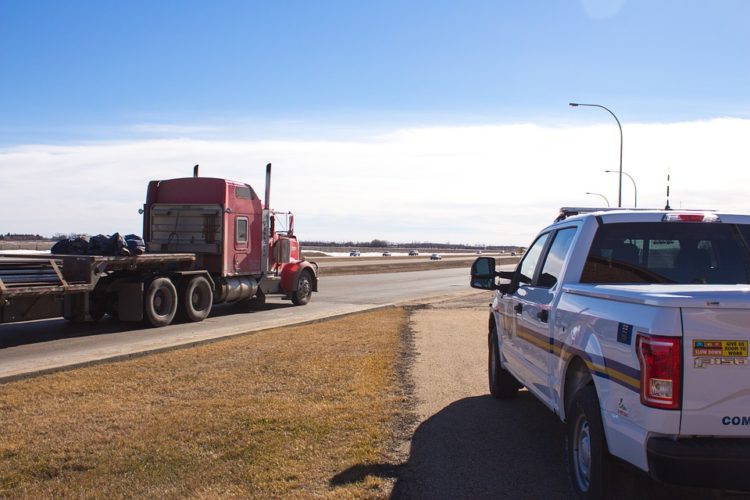Top 11 Tips to Survive a Roadside Inspection

Listen up!
Check out our podcast, Freight Nation, where industry experts talk all things trucking.
Regardless of how long you’ve been an owner-operator or a carrier, if your truck is old or new, no matter what lanes you run, there will come a time when you are waved in for a Roadside Inspection.
First, take a deep breath, and don’t panic. It can be easy to get worked up over a process that takes you off the road and could end in citations, but try to remember that EVERYONE gets inspected, typically every year.
With some preparation and patience, many truck drivers understand that it’s possible to reduce the number and the duration of roadside walk-arounds that turn into full-fledged Level I under-the-truck inspections.
Here are 11 tips to increase your chances of getting back on the road quickly and without a citation.
1. Always perform a DVIR.
Having a quick Federal Motor Carrier Safety Administration (FMCSA) Roadside Inspection is only one reason why you should be performing regular pre-trip inspections every time you hit the road. Follow a Driver’s Vehicle Inspection Report (DVIR) to make sure you’re checking off all the right boxes on your truck. This includes checking your battery, brakes, clutch, defrost, exhaust, horn, lights, mirrors, safety equipment, tires, and windows, just to name a few. Attention to detail in this process will pay off during a typical roadside inspection, not to mention it’s just a safer way to roll.
2. Review the Annual Vehicle Inspection Report.
Regularly review the FMCSA’s Annual Vehicle Inspection Report, especially before your area’s Department of Transportation (DOT) inspection period every summer. This report details all of the same items that will be checked if you get waved in for a Level I Roadside Inspection.
3. Keep your truck clean.
Keep your truck, tires, wheels, and interior as clean as you can. Many drivers believe this is the key to a speedy inspection because it lets the inspector know that you’re responsible and detail-oriented. Plus, it keeps everything visible to them for a quick walkaround.

4. Know where your emergency supplies are.
Make sure you always know where your roadside emergency warning triangles and the fire extinguisher are at all times. This will help you in a variety of situations, but also during a roadside inspection.5. Don’t rush it.
If you get waved in for a closer look after a Roadside Inspection, don’t be in a rush. Pull in slowly, follow the signs, and carefully watch for foot traffic in the inspection area. You don’t want to make an inspector angry by being inpatient.
6. No radar detectors.
The FMCSR doesn’t allow radar detectors, so don’t have one in your cab, period.

7. Make sure Droolius Caesar is secure.
Do you travel with a dog? The first thing to do once you get parked is to put them in a secure dog carrier, especially if they’re aggressive or skittish. Not only does this help the inspector do their job, it keeps your dog safe from traffic while you’re hunched over your paperwork.
8. Admit to any known problems.
Be upfront about any problems that may cause further inspection. Some drivers report that an inspector may waive the citations if you’ve demonstrated that you know about the issue, discovered it recently, and are making steps to get it fixed as soon as possible.
9. Know how to work your ELD.
The inspector will need to see your ELD logs, so make sure you know how to email your e-logs to the inspector. Understanding how your ELD works and helping the inspector find what they need will speed up the entire process and get you back on the road.
10. Have your documents in order.
Make sure you have your documentation organized and in order, ideally in a binder or folder that you can easily access. The following documents are what you’re going to need:
- Driver’s license
- Registration
- Vehicle insurance
- Medical Examiner’s Certificate
- Record of Duty Status
- Annual inspection records
- Hazardous materials paperwork
- IFTA card
- Permit credentials.

11. Carry extra equipment for securing loads.
Always have plenty of equipment with you for securing loads. Incorrectly secured loads are one of the most frequently reported problems at Roadside Inspections. If you run into a snag in this area, some inspectors may simply have you tighten up a few things and send you on your way, as opposed to write you a citation. You’ll never be sorry that you spent a bit more to carry extra tarps and straps.
The best possible advice for passing an FMCSA Roadside Inspection is to be prepared.
During an FMCSR Level I Roadside Inspection, there are some common equipment problems that lead to delays, citations, or an Out-of-Service (OOS) Order. Create a habit of prioritizing the following items every day, and you’ll thank yourself later.
- Brakes that are out of adjustment or other brake problems
- Tires that are under-inflated or too worn
- Securing of the load
- Damage to lights
- Windshield damage or obstruction
- Oil leaks
Drive safe out there!
Topics:

Find out how our platform gives you the visibility you need to get more done.
Get helpful content delivered to your inbox.
Schedule a demo.
Find out how our platform gives you the visibility you need to get more done.





